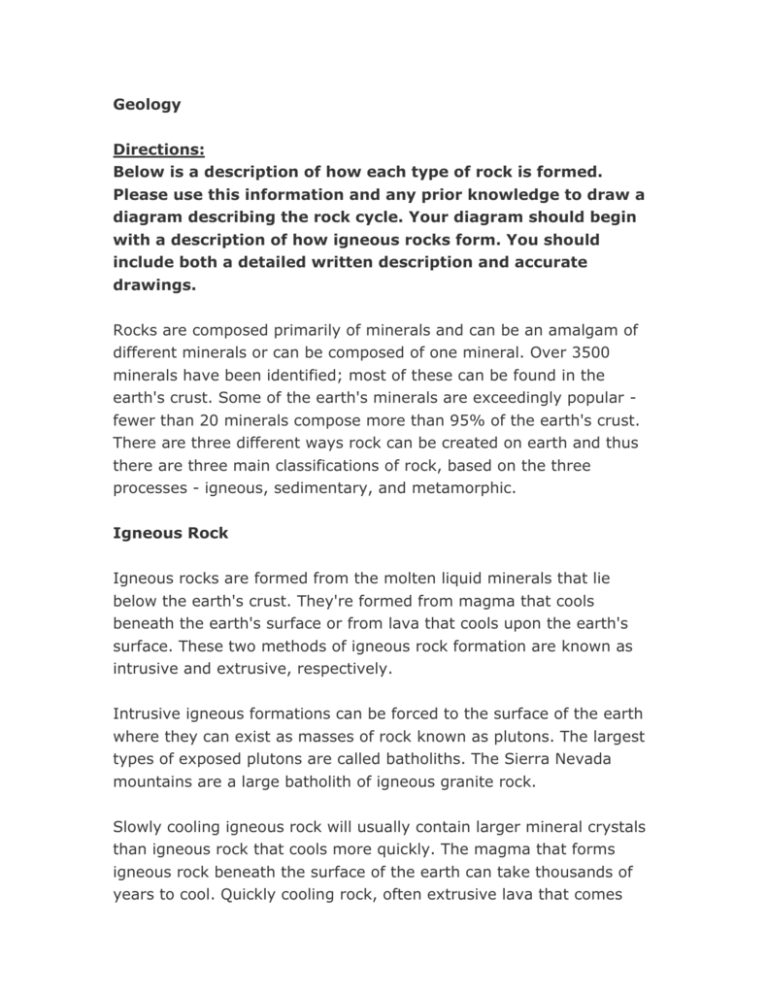Geology - Unit 3 - Rock formation notes
advertisement

Geology Directions: Below is a description of how each type of rock is formed. Please use this information and any prior knowledge to draw a diagram describing the rock cycle. Your diagram should begin with a description of how igneous rocks form. You should include both a detailed written description and accurate drawings. Rocks are composed primarily of minerals and can be an amalgam of different minerals or can be composed of one mineral. Over 3500 minerals have been identified; most of these can be found in the earth's crust. Some of the earth's minerals are exceedingly popular fewer than 20 minerals compose more than 95% of the earth's crust. There are three different ways rock can be created on earth and thus there are three main classifications of rock, based on the three processes - igneous, sedimentary, and metamorphic. Igneous Rock Igneous rocks are formed from the molten liquid minerals that lie below the earth's crust. They're formed from magma that cools beneath the earth's surface or from lava that cools upon the earth's surface. These two methods of igneous rock formation are known as intrusive and extrusive, respectively. Intrusive igneous formations can be forced to the surface of the earth where they can exist as masses of rock known as plutons. The largest types of exposed plutons are called batholiths. The Sierra Nevada mountains are a large batholith of igneous granite rock. Slowly cooling igneous rock will usually contain larger mineral crystals than igneous rock that cools more quickly. The magma that forms igneous rock beneath the surface of the earth can take thousands of years to cool. Quickly cooling rock, often extrusive lava that comes from volcanoes or fissures in the earth's surface has small crystals and may be quite smooth, such as the volcanic obsidian rock. All rocks on earth were originally igneous as that's the only method entirely new rock can be formed. Igneous rocks continue to form today under and above the earth's surface as magma and lava cool to form new rock. The word igneous comes from Latin and means "fire formed." Most of the rocks of the earth's crust are igneous although sedimentary rocks usually cover them. Basalt is the most common type of igneous rock and it covers the ocean floor and thus, exists over two-thirds of the earth's surface. Sedimentary Rock Sedimentary rocks are formed by the lithification (cementing, compacting, and hardening) of existing rock or the bones, shells, and pieces of formerly living things. Rocks are weathered and eroded into tiny particles which are then transported and deposited along with other pieces of rock called sediments. Sediments are cemented together and compacted and hardened over time by the weight and pressure of up to thousands of feet of additional sediments above them. Eventually, the sediments are lithified and become solid sedimentary rock. These sediments that come together are known as clastic sediments. Sediments usually sort themselves by the size of the particles during the deposition process so sedimentary rocks tend to contain similarly sized sedimentary particles. An alternative to clastic sediments are chemical sediments which are minerals in solution that harden. The most common chemical sedimentary rock is limestone, which is a biochemical product of calcium carbonate created by the parts of dead creatures. Approximately three-quarters of the earth's bedrock on the continents is sedimentary. Metamorphic Rock Metamorphic rock, which comes from the Greek to "change form," is formed by applying great pressure and temperature to existing rock converting it into a new distinct type of rock. Igneous rocks, sedimentary rocks, and even other metamorphic rocks and be modified into metamorphic rocks. Metamorphic rocks are usually created when they come under extreme pressure such as under many thousands of feet of bedrock or through being crushed at the junction of tectonic plates. Sedimentary rocks can become metamorphic rocks if the thousands of feet of sediments above them apply enough heat and pressure to further change the structure of the sedimentary rock. Metamorphic rocks are harder than other types of rock so they're more resistant to weathering and erosion. Rock always converts into the same type of metamorphic rock. For example, the sedimentary rocks limestone and shale become marble and slate, respectively, when metamorphosed. The Rock Cycle We know that all three rock types can be turned into metamorphic rocks but all three types can also be changed through the rock cycle. All rocks can be weathered and eroded into sediments, which can then form sedimentary rock. Rocks can also be completely melted into magma and become reincarnated as igneous rock.








